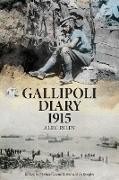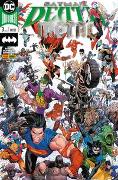Gallipoli Diary 1915
BücherAngebote / Angebote:
We had a look around, through periscopes, at the remains of recent fighting. The dead were on top, and we, the living, were below the general ground-level. The usual order of life and death were reversed."So wrote Alec Riley in his account of an ordinary soldier in an extraordinary conflict, the Gallipoli Campaign of 1915. A signaller with the 42nd (East Lancashire) Division, Riley was well placed to serve as an eyewitness to the sharp end of the campaign, being with the infantry but not of it. His task, and that of the small unit he served with and whose story he tells, was to maintain communications between the forward trenches and senior commanders in the rear, a conduit for at times unrealistic orders one way, and all-too-real situation reports the other. During his time on the peninsula, Riley kept meticulous notes, which form the basis of this account. He also took his camera to war, the resulting photos - some of which were used in the British official history of the campaign - flesh out his detailed story of life in and behind the lines.After four months on the peninsula, suffering from jaundice, septic sores and dysentery, Riley was evacuated sick, destined first for Mudros and then Blighty. He made sure to save his diary and camera. Although Gallipoli had done for Riley, Riley was not done with Gallipoli. Even while on the peninsula, he and his comrades had looked beyond the war."We tried to imagine what the place would be like when the armies had gone. Achi Baba would be green again, the trenches would fall in and flatten, communication-trenches, through which thousands of men had passed, would be long and shallow depressions, and frogs and tortoises the only inhabitants of gully and nullah."Remarkably, Alec Riley returned to find out, revisiting the peninsula at least twice. In 1930, he spent ten days wandering across the now overgrown fields of battle on a lone pilgrimage, revisiting places he knew intimately 15 years before.This pilgrimage, and a subsequent second visit, was intended to form the basis of a book, again illustrated with his trusty camera. Sadly, the original manuscript has been lost. But the editors have identified two extracts that appeared in print, which they present alongside a faithful transcript of Riley's diary and notes.Also included is an unpublished introduction by General Sir Ian Hamilton, commander of the Mediterranean Expeditionary Force of which Riley had been a small part, and with whom Riley had a decade-long correspondence. Chapters on the flora, fauna, and geography of the peninsula, along with its history modern and ancient, formed part of Riley's guide to the battlefields. They provide useful context for today's visitors to Gallipoli.The editors of the diary, Michael Crane and Bernard de Broglio, have added copious footnotes and detailed biographical notes on the officers and men who come to life in Riley's writings, as well as an order of battle and summary of arms for the 42nd Division at Gallipoli. Fourteen maps illustrate the actions, large and small, that Riley describes, alongside 47 black and white photographs showing the battlefield in 1915 and 1930.Gallipoli Diary 1915 offers the reader a rare perspective on the Gallipoli campaign. Alec Riley saw Helles in war, and returned to explore what remained when the armies had gone.
Folgt in ca. 10 Arbeitstagen


